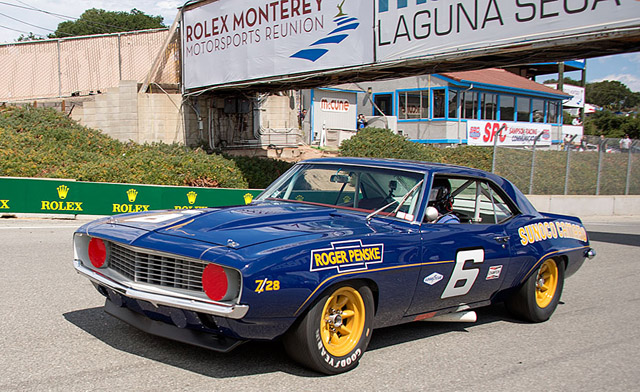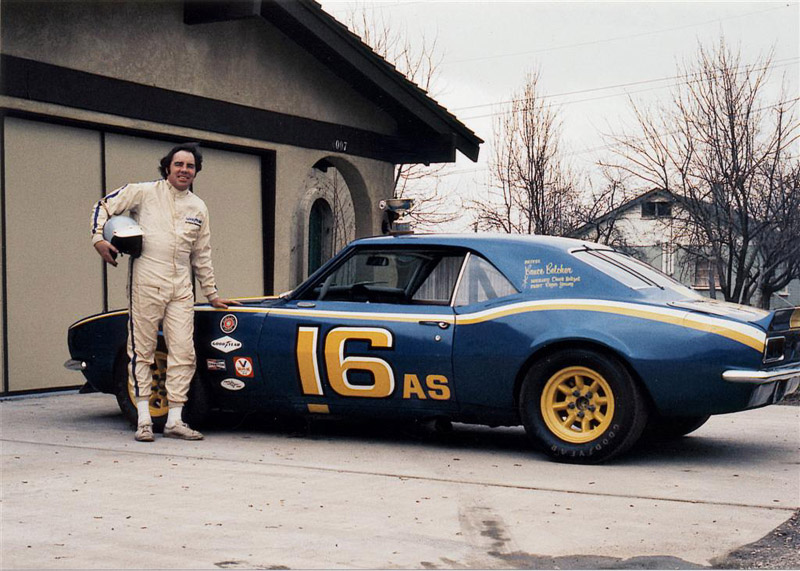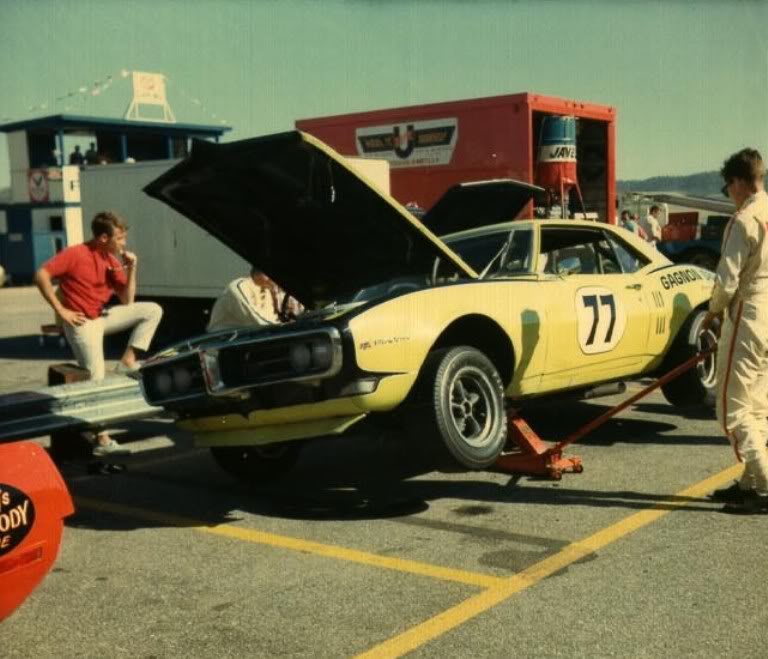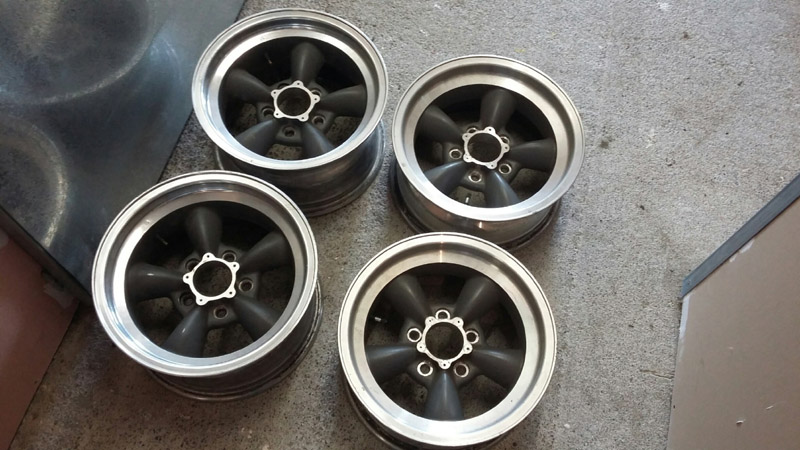From 1968, the maximum wheel width allowed was 8 inches.
When Terry Allen brought his Camaro with 396 rat motor to Bay Park in 1970, his wheels were 12 inch front and back.
From 1968, the maximum wheel width allowed was 8 inches.
When Terry Allen brought his Camaro with 396 rat motor to Bay Park in 1970, his wheels were 12 inch front and back.
Steve, I can only quote direct from Motorman magazine that covered this event.May 1970 page 12
Allans iridescent blue Camaro sitting on Minilites and 12 inch Goodyears all around, disc brakes on all four wheels and a 390 cu in "rat" Chevvy engine on 58mm side draught Webers..........
I am quite happy to accept that I didnt check the article to see if the wheels were 12 inch.
Serious bulge though-2 inches.
Car suspension is set high, so clearance was OK
doesnt look like anyone now could do it in HMC-
3.13 Tyres: Only tyres for legal road use in New Zealand may be used. (ie.
approved road tyres having 1.5 mm minimum tread depth across 75% of the
width of the tyre and around the entire circumference at the tyre, Drag Race DOT
Tyres not allowed, nor is the practice of skimming the tyres. Aspect ratio is
restricted to 50% minimum. Non DOT Goodyear Blue Streak 15” G7 Period
Vintage Race Tyres, along with 15” Hoosier TD’s and HOTD’s are allowed. Non
DOT Period 15” Vintage Race Tyres in Goodyear Blue Streak G7 up to 6.00X15
Front and 7.00X15 Rear, along with Hoosier 15” HOTD’s up to 25.5X8.5 Front
and 26.5X9.5 Rear and TD’s up to P225/60D15 Front and P245/60D15 Rear are
allowed.
Looks like I am not the only one not watching the Test rugby.....
I think the HMC tyre size rule is the same as they use in Historic Trans-Am. Historic Trans-Am caters to the original cars that raced during the 1966 - 1972 era, but obviously the earlier cars originally wore much narrower tyres than those in the later years. The HTA rule is set at a sort of middle-ground so the earlier cars aren't so disadvantaged, as they couldn't fit the much fatter rubber.
The theory in period was that although there was a maximum 8 inch wheel width rule, there was no rule on tyre width, so the wider the tyre, the more rubber making contact with the road, the more grip the car had.
I'd guess that the Historic Trans-Am tyre size falls at around the size of the tyres being used in the 1968 season. By 1969, the tyres had really got fat, and bulged way out from the rim. The below photos are a good example of the differences between what was being used on the Penske Camaros in 1969, and the same car as raced in Historic Trans-Am. You can see how much less bulge there is in the tyre wall on the car as it races today.

Wheels and Tyres continued:
American Racing wheels were made from magnesium, and were extremely light. The company eventually began producing them in aluminium, for people to fit to their road cars, but most of the racers used the magnesium examples.
American Racing 5-spoke wheels continued their popularity in 1967, and 1968, despite there being increased competition from other brands. Throughout both 1967 and 1968, virtually every team used American Racing Torq Thrust 5-spoke wheels.
For 1969, American Racing released their new 200-S wheel design, commonly referred to as the ‘daisy’ wheel because of the shape of its five spokes. The alloy version of the 200-S is shown above. Once again, most of the factory teams opted for this wheel, simply because it was the latest and greatest from American Racing. However, the 200-S suffered some early failures, and while American Racing quickly got to work upgrading it to a more durable 6-spoke design, by this stage many teams had switched to the new 8-spoke magnesium Minilite wheel, which remained the most popular choice for years to come.
I found this image on a model car site showing the Torq Thrust (right) and Minilite wheels, and the design differences.
The Minilite wheel is hard to beat for pure sex-appeal, but in the Trans-Am series, a 1967/68 model car, such as mine, wouldn’t have worn Minilites when it was new, because the Minilite hadn’t yet made its entrance into the series. It only arrived in 1969. So while pre-1969 cars may have raced during the 1969 and later seasons fitted with Minilites, these were by now outdated cars. Below is the Penske Camaro raced by Mark Donohue from the Continental Divide round of the 1968 Trans-Am series. When new, this car was fitted with American Racing Torq Thrust wheels.
At the end of the 1968 season, this car was sold, and the team built two new 1969 Camaros. But Penske bought this car back in 1969, when they became paranoid rival Ford teams may sacrifice one of their cars to eliminate Donohue, who was running away with the championship. Once back in the Penske fold, the year-old Camaro was updated with new engine, and fitted with 8-spoke Minilite wheels, as the team were now using on their latest 1969 Camaros. The Camaro spent the rest of its active career fitted with Minilites, as seen in the below mid-1970s photo when owned by Bruce Belcher, but when it was eventually purchased and restored back to its 1968 guise by Tom McIntyre, it was also refitted once more with 5-spoke Torq Thrust wheels.

What a find with the 3 magnesium American Racing rims. They will look very cool
Steve,
With all the rules and regulations perhaps you could get the "All Comers " class going where anything goes and you see cars like this;
or this.
All the best, you are doing a fabulous job in so many areas.
We are proud of you.
Sincerely,
Ken
Hi Ken, many thanks, I really appreciate that. I I appreciate the support you and others have provided me.
I'm already involved in a group in NZ called Historic Muscle Cars and Historic Saloon Cars. Interestingly, the reason we created these groups was because classic and historic racing in NZ had pretty much taken on an allcomer-style flavour, with no regulations and no policing. We actually wanted to introduce rules to create some stability, and provide car owners a better return on their investment, as the ongoing costs that come with technology creep are mostly wiped out. Someone could spend a million dollars building an HMC car, but the rules are created in such a way to really won't be much faster, if at all, to a $50,000 car.
Thats the difference between NZ and other countries, such as the US where you are. The US have introduced stability, and for the most part kept technology out of historic racing. But I can see that there are probably people in the US and other countries who feel hemmed in by having tight regulations and would instead love a free-for-all allcomer group. However, what we wanted when we created HMC/HSC was to have tight regulations, because its something we've never had in NZ. I guess its a case of the grass always being greener on the other side.
Steve,
That was a well written reply to something I should have stayed away from, thank you, but when I went to racing at Pukekohe the fields looked like this; Jan 4 1969. NZGP. Pukekohe.
The Open Race for Saloon Cars would bring the crowd to its feet.
There certainly was a variety of cars. Note the Anglia of Bryan Marshall had a 997 cc engine and Neil Doyle also had an Anglia with a 5463 c.c. Corvette engine in it ! Allcomers Included indeed !
It shows how long I have been away from NZ racing !
(Ken H)
I will say no more.
Last edited by khyndart in CA; 07-04-2017 at 09:05 PM.
Hi Ken, I love the entry list. Outstanding! By 1969 the NZ Saloon Championship was open to Group 5 cars, and the allcomers had been ousted, but clearly allcomer all-in races still took place, and were still very popular. I think in many cases allcomer races were held at prominent events because there were often international teams competing that didn't fit the NZ rules.
I always enjoy your posts Ken, keep them coming.
That's a yes from me too, If there is some more info, That is so unique. Split window Morrie with a v12........ Morr-guar??
Cheers
Sorry to disappoint you Paul and Grant but I was looking for some Garth Souness Morrari engine shots and came across this Moggy Jag pix. I did not mean to get this thread off track too far but I grew up with All-Comers / Unlimited saloons and it is still in my veins !
I did find this USA Jalopy Journal 2007 site had some interesting comments and photos etc.
H.A.M.B. "Hokey Assed Message Board"
https://www.jalopyjournal.com/forum/...aloons.163607/
(Ken H )
Wheels and Tyres continued:
Its popular these days to fit cars of 1965/66/67 vintage with Minilite wheels, and many of the cars competing throughout the world in historic racing are fitted with these wheels. And they look great. But for period accuracy, these cars should wear either factory steel wheels or Torq Thrust wheels because the Minilite was still a few years away when these cars were new.
So too, there are numerous 1967 and ’68 Camaros in historic racing which are fitted with Minilites. But these cars wouldn’t have worn these wheels when new. They would have had Torq Thrust wheels. That’s not to say there weren’t 1967 and ’68 Camaros that raced in period with Minilite wheels. Its just that they would have been two or three years old when fitted with this style of wheel. Meanwhile, a 1969/70 Mustang, 2nd gen Camaro, etc is a better fit for Minilite or American Racing 200-S daisy wheels than Torq Thrusts, as these were the in-thing by 1969. All the factory Trans-Am teams used Minilites in 1969, while both the factory Mustangs and Firebirds started out wearing daisy wheels. Sounds kind of lame, I know, but for an anorak, having the right wheel to match the car is important.
Of course, there are exceptions when it comes to original cars. Many privateer teams competing in SCCA A/Sedan and Trans-Am races had older equipment, either cars purchased second hand from factory teams, or self-built cars, often using a wrecked or older road car as the basis. So it was common to see guys racing 1967/68 Camaros and Mustangs fitted with Minilite wheels in 1969, 1970 etc. And in the cases where these cars still exist, they’re usually restored correctly, as raced in period. So too, cars like Bob Janes 1969 Camaro that won the 1971 and ’72 ATCCs, this car was built in 1970. It never wore anything other than Minilites.
However, for a car like mine being built from scratch as a replica of a semi-factory team car, I think its best to fit the latest style of wheel that was available and popular when that make/model was new. After all, the goal here is to make my car as accurate as possible to the original Craig Fisher Firebird.

For my car to look right, only the American Racing 5-spoke Torq Thrust wheel will do. However, American Racing of today are not American Racing of the 1960s. These days they’re a conglomerate who produces a huge number of wheels for an almost endless number of applications, including people movers and SUVs. So too, the 5-spoke wheel of the 1960s is no longer being produced. The closest in the current American Racing line-up is the Torq Thrust D. But the Torq Thrust D has a number of subtle differences to the original 5-spoke items of the ‘60s, with much more rounded spokes. Its no longer made from magnesium either, but that’s not a problem for a broken-arse pauper like me!
For those looking for a wheel that closely resembles the original 5-spoke American Racing wheel of the 1960s, there aren’t many options. Back in the 1980s, Phil Schmidt Engineering produced a beautiful looking wheel from alloy that was virtually identical to the original American Racing 5-spoke wheels. But Phil Schmidt sold his company some years ago, and this particular wheel is no longer being produced.
Vintage Engineering produce a gorgeous looking series of magnesium wheels for various racing applications, including an accurate replica of the 1960s American Racing 5-spoke. However, these wheels are expensive, at approx. US$1000 per wheel, which is way out of my league. As much as I’d love to order a set, being way down in New Zealand, I’d really need to also order a couple of spares, so I’d be all-in at US$6000, or approx NZ$10000. I just can’t afford that.
So I’ll go with the American Racing Torq Thrust D wheels, which while not completely accurate to the originals, are still a great looking wheel, and are affordable and readily available.
I got my wheels from Ian Woodward. Woody emailed me about getting some Monster Race Wear t-shirts done for his business, and I said rather than you pay for the tees, get me a set of used Torq Thrust wheels. American Racing are one of the sponsors of Australian Trans-Am. This he duly did, and brought them with him when the eight Australian Trans-Am cars came to race with HMC at Hampton Downs earlier this year.
I asked Woody to get me four 15 x 8 wheels, which is the correct size for a Trans-Am car. For some reason he got me two 8 inch and two 7 inch wheels. Having spoken to a couple of people running 7’s on the front of their cars, they reckon they provide excellent turn-in. However, I'd prefer to have 8 inch wheels on the front. I’m now thinking I might have to get a pair of 8.5 wheels for the rear, as the off-set is better, and provides a little more space within the inner guards for the fat tyres we run. So I have a few options there to consider. Once again, this was a really generous contribution from a good friend trying to help me out.

The still will look cool on the car Steve.